英语语法之一般过去时
- 格式:ppt
- 大小:195.00 KB
- 文档页数:8

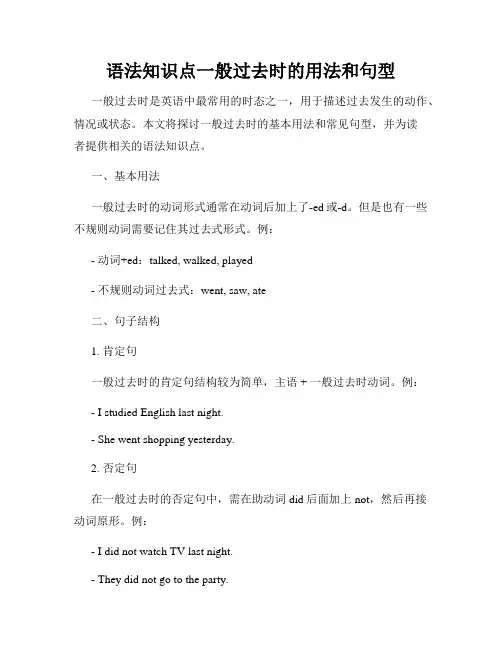
语法知识点一般过去时的用法和句型一般过去时是英语中最常用的时态之一,用于描述过去发生的动作、情况或状态。
本文将探讨一般过去时的基本用法和常见句型,并为读者提供相关的语法知识点。
一、基本用法一般过去时的动词形式通常在动词后加上了-ed或-d。
但是也有一些不规则动词需要记住其过去式形式。
例:- 动词+ed:talked, walked, played- 不规则动词过去式:went, saw, ate二、句子结构1. 肯定句一般过去时的肯定句结构较为简单,主语 + 一般过去时动词。
例:- I studied English last night.- She went shopping yesterday.2. 否定句在一般过去时的否定句中,需在助动词did后面加上not,然后再接动词原形。
例:- I did not watch TV last night.- They did not go to the party.3. 一般疑问句一般过去时的一般疑问句需要将助动词did放在句首,然后将主语放在did后面,接原形动词。
例:- Did you finish your homework yesterday?- Did they visit their grandparents last weekend?三、时间状语一般过去时常与表示过去时间的状语连用,以明确动作或状态发生的时间。
以下是一些常用的时间状语:- yesterday- last week/month/year- in 1990- a few days ago- when I was a child- at that time- in the past四、陈述句和疑问句的回答在陈述句中,我们通常用完整的句子回答,而在疑问句中,我们可以用简略回答或完整回答。
例:- Did you go to the party? - Yes, I did. / No, I didn't.- Did he finish his homework? - Yes, he did. / No, he didn't.五、经常与一般过去时连用的词汇1. 过去连续性的动作:- was/were + 动词-ing:I was playing basketball when she called me. - used to + 动词原形:I used to walk to school when I was young.2. 时间副词:- ago:He moved to New York two years ago.- before:I had never seen such a beautiful scenery before.- when:I was reading a book when the phone rang.3. 愿望:- wish + 一般过去时:I wish I knew the answer.六、一般过去时的注意事项1. 与现在的区别:一般过去时描述过去的动作、情况或状态,与现在时相对应。
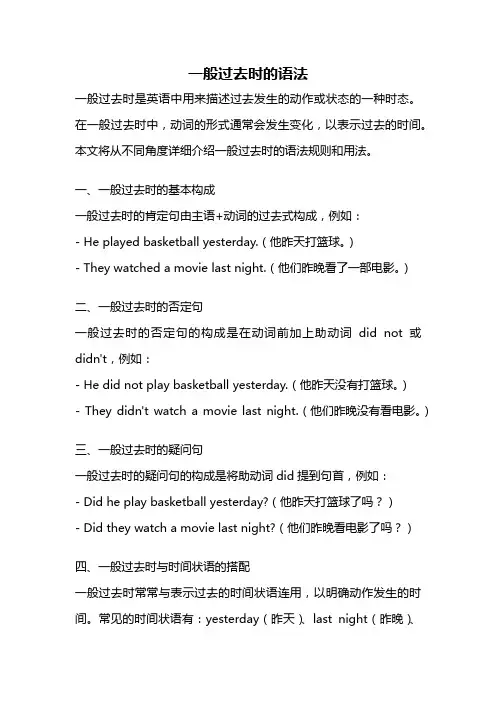
一般过去时的语法一般过去时是英语中用来描述过去发生的动作或状态的一种时态。
在一般过去时中,动词的形式通常会发生变化,以表示过去的时间。
本文将从不同角度详细介绍一般过去时的语法规则和用法。
一、一般过去时的基本构成一般过去时的肯定句由主语+动词的过去式构成,例如:- He played basketball yesterday.(他昨天打篮球。
)- They watched a movie last night.(他们昨晚看了一部电影。
)二、一般过去时的否定句一般过去时的否定句的构成是在动词前加上助动词did not或didn't,例如:- He did not play basketball yesterday.(他昨天没有打篮球。
)- They didn't watch a movie last night.(他们昨晚没有看电影。
)三、一般过去时的疑问句一般过去时的疑问句的构成是将助动词did提到句首,例如:- Did he play basketball yesterday?(他昨天打篮球了吗?)- Did they watch a movie last night?(他们昨晚看电影了吗?)四、一般过去时与时间状语的搭配一般过去时常常与表示过去的时间状语连用,以明确动作发生的时间。
常见的时间状语有:yesterday(昨天)、last night(昨晚)、last week(上周)、in 2010(在2010年)等等。
五、一般过去时的用法1. 表示过去发生的动作或状态She lived in New York for five years.(她在纽约住了五年。
)2. 表示过去经常或反复发生的动作He often went swimming when he was young.(他年轻时经常去游泳。
)3. 表示过去的习惯或常态She always cooked dinner for her family.(她过去总是为家人做晚饭。
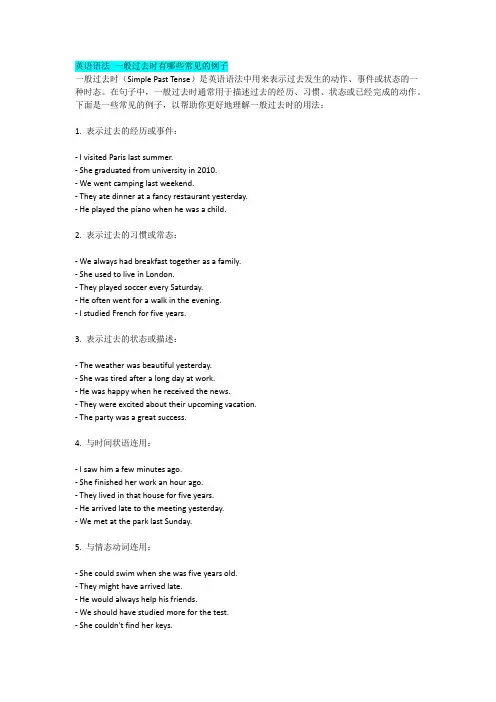
英语语法一般过去时有哪些常见的例子一般过去时(Simple Past Tense)是英语语法中用来表示过去发生的动作、事件或状态的一种时态。
在句子中,一般过去时通常用于描述过去的经历、习惯、状态或已经完成的动作。
下面是一些常见的例子,以帮助你更好地理解一般过去时的用法:1. 表示过去的经历或事件:- I visited Paris last summer.- She graduated from university in 2010.- We went camping last weekend.- They ate dinner at a fancy restaurant yesterday.- He played the piano when he was a child.2. 表示过去的习惯或常态:- We always had breakfast together as a family.- She used to live in London.- They played soccer every Saturday.- He often went for a walk in the evening.- I studied French for five years.3. 表示过去的状态或描述:- The weather was beautiful yesterday.- She was tired after a long day at work.- He was happy when he received the news.- They were excited about their upcoming vacation.- The party was a great success.4. 与时间状语连用:- I saw him a few minutes ago.- She finished her work an hour ago.- They lived in that house for five years.- He arrived late to the meeting yesterday.- We met at the park last Sunday.5. 与情态动词连用:- She could swim when she was five years old.- They might have arrived late.- He would always help his friends.- We should have studied more for the test.- She couldn't find her keys.6. 否定句和疑问句:- I did not go to the party.- Did she see the movie?- They didn't finish their homework on time.- Was he at home yesterday?- Did you have a good time at the concert?7. 连词连用:- When I was a child, I loved playing outside.- While they were cooking, I set the table.- As I walked down the street, I saw an old friend.这些例子涵盖了一般过去时在不同语境下的应用。
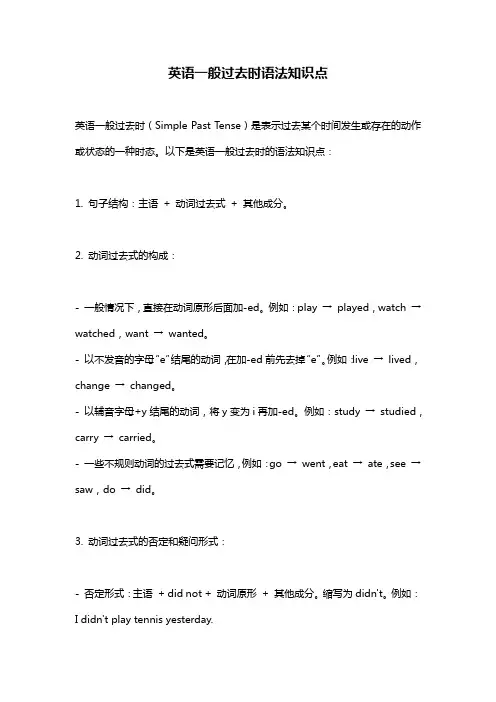
英语一般过去时语法知识点英语一般过去时(Simple Past Tense)是表示过去某个时间发生或存在的动作或状态的一种时态。
以下是英语一般过去时的语法知识点:1. 句子结构:主语+ 动词过去式+ 其他成分。
2. 动词过去式的构成:- 一般情况下,直接在动词原形后面加-ed。
例如:play →played,watch →watched,want →wanted。
- 以不发音的字母“e”结尾的动词,在加-ed前先去掉“e”。
例如:live →lived,change →changed。
- 以辅音字母+y结尾的动词,将y变为i再加-ed。
例如:study →studied,carry →carried。
- 一些不规则动词的过去式需要记忆,例如:go →went,eat →ate,see →saw,do →did。
3. 动词过去式的否定和疑问形式:- 否定形式:主语+ did not + 动词原形+ 其他成分。
缩写为didn't。
例如:I didn't play tennis yesterday.- 疑问形式:Did + 主语+ 动词原形+ 其他成分例如:Did you watch the movie last night?4. 一般过去时的时间状语:昨天(yesterday)、上个月(last month)、去年(last year)等表示过去某个具体时间的时间状语。
5. 一般过去时的用法:- 表示过去某个具体时间发生的动作或状态。
例如:I went to the beach yesterday.- 表示过去一段时间内发生的动作或状态。
例如:I lived in London for two years.- 表示过去习惯性的动作或状态。
例如:When I was a child, I always played with my friends.以上就是英语一般过去时的语法知识点。
记得多加练习,熟练掌握一般过去时的用法。

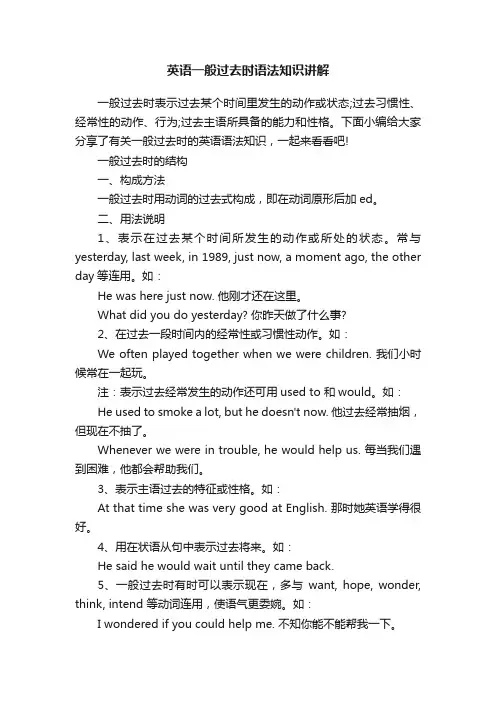
英语一般过去时语法知识讲解一般过去时表示过去某个时间里发生的动作或状态;过去习惯性、经常性的动作、行为;过去主语所具备的能力和性格。
下面小编给大家分享了有关一般过去时的英语语法知识,一起来看看吧!一般过去时的结构一、构成方法一般过去时用动词的过去式构成,即在动词原形后加ed。
二、用法说明1、表示在过去某个时间所发生的动作或所处的状态。
常与yesterday, last week, in 1989, just now, a moment ago, the other day等连用。
如:He was here just now. 他刚才还在这里。
What did you do yesterday? 你昨天做了什么事?2、在过去一段时间内的经常性或习惯性动作。
如:We often played together when we were children. 我们小时候常在一起玩。
注:表示过去经常发生的动作还可用used to 和would。
如:He used to smoke a lot, but he doesn't now. 他过去经常抽烟,但现在不抽了。
Whenever we were in trouble, he would help us. 每当我们遇到困难,他都会帮助我们。
3、表示主语过去的特征或性格。
如:At that time she was very good at English. 那时她英语学得很好。
4、用在状语从句中表示过去将来。
如:He said he would wait until they came back.5、一般过去时有时可以表示现在,多与want, hope, wonder, think, intend 等动词连用,使语气更委婉。
如:I wondered if you could help me. 不知你能不能帮我一下。
6、有时用一般过去时也是时态一致的需要。
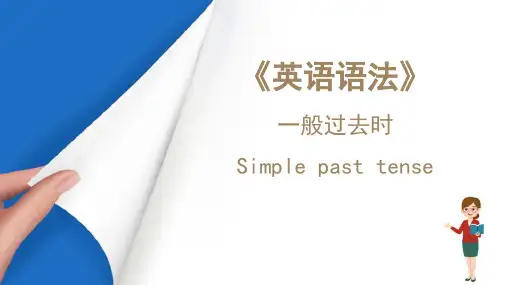
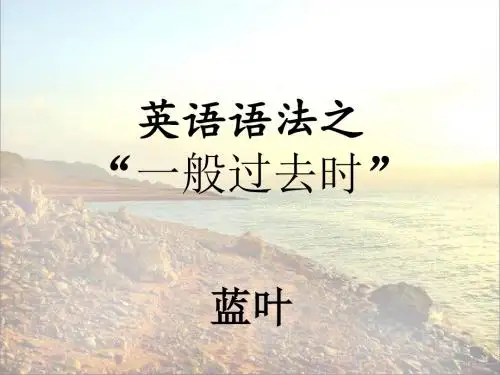

英语学习:一般过去时语法解释大全一、基本概念一般过去时是英语中的一种基本时态,表示在过去某个时间发生的动作或状态。
它常用于描述已经发生的事情,特别强调该动作或状态与现在没有直接联系。
二、动词变化1. 规则动词:大多数动词的过去式形式是在动词后面加上-ed。
例如:work-worked, write-wrote。
2. 不规则动词:一些动词的过去式形式与其他动词不同。
例如:be-was/were, have-had, do-did。
3. 特殊情况:有些动词的过去式形式与动词原形相同,如:go-went, see-saw。
三、时间状语一般过去时通常与表示过去的时间状语一起使用,如:yesterday, last night, three days ago等。
四、与其他时态比较1. 现在完成时vs 一般过去时:现在完成时强调动作对现在的影响或结果,而一般过去时只关注过去的动作或状态。
例如:“I have seen the movie”(我已经看过这部电影)应该使用现在完成时,而不是一般过去时。
2. 一般现在时vs 一般过去时:一般现在时描述现在的状态或习惯,而一般过去时描述过去的状态或习惯。
例如:“I usually watch TV at night”(我通常在晚上看电视)应该使用一般现在时,而不是一般过去时。
五、特殊用法1. 表达过去的经验:例如:“I visited Paris last year”(我去年参观了巴黎)。
2. 表达假设条件:例如:“If I were you, I would do it”(如果我是你,我会去做这件事)。
六、与过去进行时的区别1. 时间焦点:过去进行时强调在过去某一段时间正在发生的动作,而一般过去时描述过去的某个时间点发生的动作。
2. 语态选择:过去进行时用于描述过去某个时刻正在进行的动作,通常使用进行体(was/were+动词ing形式),而一般过去时则直接使用动词的过去式形式。
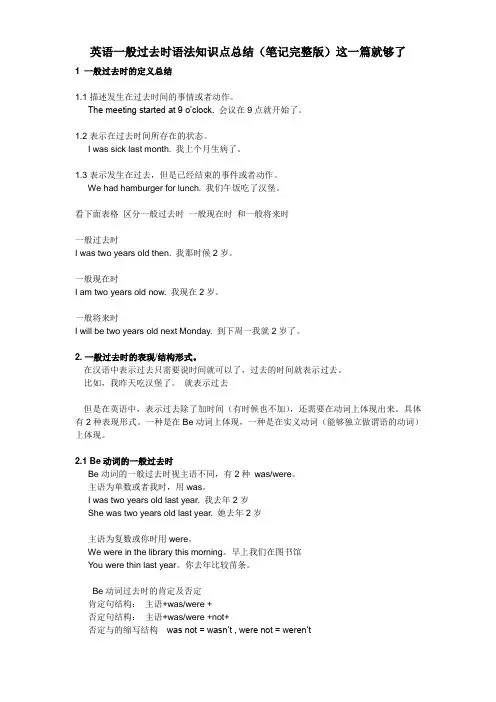
英语一般过去时语法知识点总结(笔记完整版)这一篇就够了1 一般过去时的定义总结1.1 描述发生在过去时间的事情或者动作。
The meeting started at 9 o’clock. 会议在9点就开始了。
1.2 表示在过去时间所存在的状态。
I was sick last month. 我上个月生病了。
1.3 表示发生在过去,但是已经结束的事件或者动作。
We had hamburger for lunch. 我们午饭吃了汉堡。
看下面表格区分一般过去时一般现在时和一般将来时一般过去时I was two years old then. 我那时候2岁。
一般现在时I am two years old now. 我现在2岁。
一般将来时I will be two years old next Monday. 到下周一我就2岁了。
2. 一般过去时的表现/结构形式。
在汉语中表示过去只需要说时间就可以了,过去的时间就表示过去。
比如,我昨天吃汉堡了。
就表示过去但是在英语中,表示过去除了加时间(有时候也不加),还需要在动词上体现出来。
具体有2种表现形式。
一种是在Be动词上体现,一种是在实义动词(能够独立做谓语的动词)上体现。
2.1 Be动词的一般过去时Be动词的一般过去时视主语不同,有2种was/were。
主语为单数或者我时,用was。
I was two years old last year. 我去年2岁She was two years old last year. 她去年2岁主语为复数或你时用were。
We were in the library this morning。
早上我们在图书馆You were thin last year。
你去年比较苗条。
Be动词过去时的肯定及否定肯定句结构:主语+was/were +否定句结构:主语+was/were +not+否定与的缩写结构was not = wasn’t , were not = weren’t例句:翠花去年是个胖子Cuihua was fat last year.翠花去年不胖Cuihua was not(wasn’t) fat last year.Be 动词过去时的一般疑问句,与常规一般疑问句一样,把Be动词提前即可。
一般过去时口诀一般过去并不难,表示过去(动作、状态)记心间。
动词要用过去式,时间状语句末站。
否定句很简单,didn't动词(原形)前,其它部分不要变。
疑问句也好变,did放在句子前,其它部分依次站。
特殊疑问也简单,疑问句首记心间。
最后一条请注意,动词过去要牢记。
1.概念:过去某个时间里发生的动作或状态;过去习惯性、经常性的动作、行为;2.时间状语:ago, yesterday, the day before yesterday, last week,last(year, night, month, 具体时间, just now, at the age of , one day, long ago, once upon a time(很久以前),3.动词变化规则:规则变化:1 直接加ed eg:work worked worked2 以不发音的e结尾的,+d eg:live lived lived3 以辅音字母+y结尾的,变y为i加ed eg:study stuied stuied4 以重读闭音节结尾的,双写最后的辅音字母+ed eg: stop stopped stopped不规则变化例如相等 eg:cut cut read read<注:read和read读音不同!>sit sat have/has -- had, eat--ate ,see--saw4.否定形式:was/were+not;在行为动词前加didn't,同时还原行为动词。
5.一般疑问句:was或were放于句首;用助动词do的过去式did 提问,同时还原行为动词。
She often came to help us in those days. I didn't know you were so busy.6.一般过去式的构成形式:肯定式疑问式否定式疑问否定式I worked Did I work? I did not work Did I not work?He(she,it) worked Did he(she,it)work?He (she,it)didnot workDid he(she,it)notwork?We worked Did we work? We did not work Did we not work?You worked Did you work? You did not work Did you not work? They worked Did they work? They did not work Did they not work?一般过去时表示句式:主语+过去动词+其他I had a word with Julia this morning.今天早晨,我跟朱丽亚说了几句话。
英语语法与词汇详解一般过去时一、什么是一般过去时?①表示过去某个时间里发生的动作或状态;(过去习惯性、经常性的动作、行为;过去主语所具备的能力和性格。
)二、一般过去时怎么用?①带有确定的过去时间状语时,需要使用过去时-> 表示过去时间状语的单词有:yesterday[昨天],two days ago[两天前],the other day[前几天],last year[去年],once upon a time[很久以前],just now[刚才],in the old days[过去的日子里],when I was 12 years old[当我12岁时],at + 一个时间点;-> 句子1:Her heart anguished within her when she learned that her husband had fallen in battle before 2020. [得知丈夫2020年前已经阵亡的消息,她内心万分痛苦。
]-> anguished:adj. 极度痛苦的,v. 使极度痛苦(anguish的过去式);-> 句子2:He made a decision just now.[他刚刚作出决定。
]②表示过去连续发生的动作时[注意:这种情况下,往往没有表示过去的时间状语,而通过上下文来表示。
]-> 句子1:The Chinese anticipated the European discovery of gunpowder.[中国人先于欧洲人发现火药。
]-> anticipated:adj. 预期的;期望的;v. 预料(anticipate的过去分词);盼望-> gunpowder:n. 火药;有烟火药-> 句子2:He appealed against the five-year sentence he had been given.[他对被判五年徒刑提出上诉。
(完整)初中英语语法一般过去时一:构成1.Be动词的一般过去时态.在没有实义动词的句子中使用be动词,am is的过去式为was; are的过去式为were.构成:肯定句:主语+was (were) +表语如:I XXX.(昨天我迟到了。
)否定句:主语+was (were) +not+表语如:XXX.(我们昨天没迟到)【注意】:当句中含有系动词was,were时,可直接在其后加not构成否定句。
如:I was on the Interntwhen you called me.当你打电话给我时,我在上网。
→:I was not/wasn'tonthe Internt when you called me .当你打电话给我时,我不在上网。
疑问句:Was (Were) +主语+表语如:XXX?(你昨天病了吗?)肯定回答:Yes,I was.(是的,我病了。
)否认句:No,I wasn't.(不,我没病。
)非凡疑问句:非凡疑问词+was (were) +主语+表语如:When were you born?你是甚么时候出身的?2.实义动词的一般过去时态一定句要利用动词的曩昔式,否认句和疑问句要利用助动词do和does的曩昔式did.一定句为:主语+动词曩昔式+宾语如:I went home at nine o'clock XXX.(我昨天九点钟回的家。
)否认句:主语+didn't +动词真相+宾语如:I XXX't go home XXX.(我今天没回家。
)疑问句:Did +主语+动词真相+宾语如:Did you go home yesterday?(你昨天回家了吗?)一定回覆:Yes,I did.(是的,我回了。
)否认回覆:No,I XXX't.(不,我没回家。
)3.助动词和情态动词过去式如下:shall―should(将要)用于第一人称单数will―would(将要)用于所有人称can—could(能,会)may―might(可以)must―must (必须)have to―had to(不能不)助动词和情态动词的曩昔时态要利用他们的曩昔式,背面的动词还利用真相。